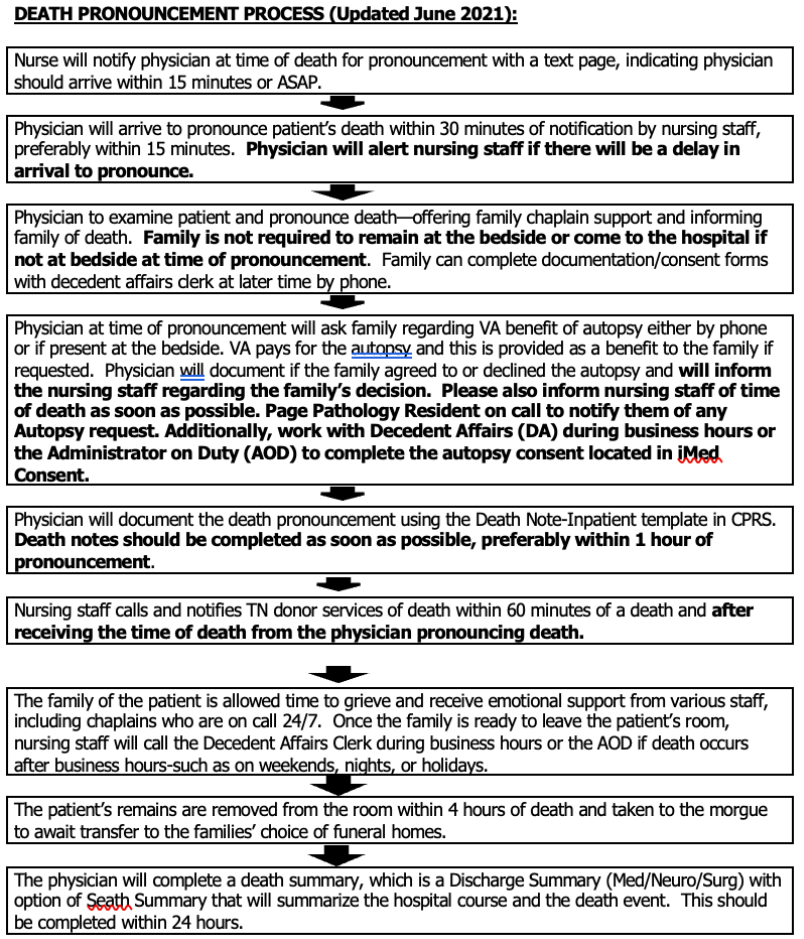The Death Pronouncement¶
Michael J. Neuss
This scenario arises in a variety of contexts, including the units, wards, and cross-cover. You might know the patient and family well, but particularly when cross covering, that may not be the case
- This approach to the death pronouncement is based in part on the AAFP’s “Death Pronouncement: Survival Tips for Residents” (Am Fam Physician. 1998 Jul 1;58(1):284-285.)
Before Entering:¶
-
Familiarize yourself with the most important points of the patient’s hospitalization and recent events. Be aware of the circumstances of the patient’s death, particularly whether death was expected or sudden.
-
Inquire as to which family is present including whether the POA is currently at bedside
-
In general, it is best to enter accompanied, ideally with the patient’s nurse. It is rare for the chaplain to be present but that might also be a consideration.
In The Room:¶
-
Especially when cross-covering, make sure to introduce yourself to family, and allow them time to introduce themselves to you
-
Less is more when it comes to what you say: it can be good to be empathetic (consider only short statements such as “I am sorry for your loss”) but focus mainly on the task at hand, allowing time for families to be present with their loved one
-
Explain that you have been called to examine the patient to confirm that they have passed. Allow a brief time for questions; it is rare (but not impossible) that someone may wish to excuse themselves for the pronouncement
-
Note the location of a working clock when you enter; your watch is ok too but do make sure to avoid looking at your smartphone to check the time of death
The Exam and Pronouncement¶
-
Identify the patient by wrist band
-
Confirm that the patient does not respond to stimuli; one discreet way to confirm a lack of response to tactile stimuli is to hold the hand, and apply pressure to a nailbed, appearing to hold the hand while looking at/visually inspecting the face or other part of the body
-
Confirm the absence of spontaneous respirations and absence of heart sounds. Listen for a full minute as some patients have extended periods of apnea
-
Examine the pupils and note the absence of pupillary light reflex
-
Note the time at which your examination is completed. This is the time of death
-
Make sure to ask if the family would like an autopsy to be performed. This is often overlooked, and as awkward as it might feel to ask for this, it is a requirement
-
Make sure you have notified the attending of record
-
Please see further VA- and VUMC-specific guidance below
Death Process at VUMC¶
-
The key thing is to ensure that all components are completed in the “Discharge as Deceased” tab under the Transfer-Discharge screen
-
EACH AND EVERY component of this tab must be completed before Decedent Affairs will accept the body
Required steps:
-
Cardiopulmonary Death Charting -> Select “New Reading” and complete.
-
Cardiopulmonary Death -> Select “+Create Note”
-
Medical Examiner Criteria -> Select “+New Reading”; Criteria requiring notification of ME is listed in a drop down menu in the navigator. Includes accidental deaths, threats to public health, suspicion for foul play, etc. The Vanderbilt Operator can assist with connecting you to the ME; alternatively, you can call 615-743-1800 during business hours (M-F 8am – 4:30pm) or the after-hours pager at 800-216-0107.
- All patients diagnosed with Covid are automatic ME cases
-
Autopsy Criteria -> Select “+New Reading”
-
Preliminary Cause of Death and Date/Time of Death ->. Rather than list “Cardiopulmonary arrest,” be specific (e.g., Pulmonary Embolism, Myocardial Infarction, Metastatic Colon Cancer, etc.)
-
Deceased’s Info – Report of Death
-
If you need to leave this and return later after collecting information, you can access your partially complete entries by clicking on the date/time text that appears under the ribbon. This is not intuitive because the numbers listing the date/time do not at all appear as though they act like a hyperlink (but they do).
-
Be specific; TDS will want you to have listed the name of the family you notified, the TDS Case Number (which the RN typically enters), and your attending physician’s name (to sign the death certificate; give their pager number in this subsection).
-
-
Report of Death Note -> Select “+New Reading” and complete.
-
Complete Synopsis + Hospital Course and then at the very bottom under Summary of Death select “+Create Note.”
-
Once all of this paperwork is finished, be sure to touch base with the patient’s nurse, usually contact Decedent Affairs and assist in making sure the body is moved
Death Process at the VA¶

VA death pronouncement process